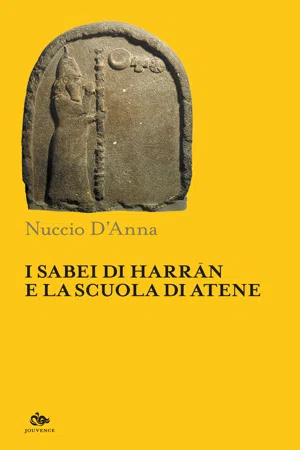
- English
- ePUB (mobile friendly)
- Available on iOS & Android
I Sabei di Harr?n e la scuola di Atene
About this book
Il libro esamina la condizione dottrinale degli ultimi neoplatonici della Scuola di Atene e mostra l'effetto dirompente dell'Editto di Giustiniano che portò alla chiusura della celebre Istituzione. Tutto ciò impose il forzato esodo verso la Persia ai rappresentanti di questa antica sapienza. L'arrivo dei neoplatonici in Persia provocò una serie di conseguenze positive sul piano spirituale e persino rituale. Tuttavia, a poco a poco quasi tutti i neoplatonici tornarono in Occidente e continuarono il loro insegnamento millenario in scuole di alto livello speculativo. In Oriente i neoplatonici ebbero significativi scambi con le élites nestoriane, mazdee e in certi casi persino con alcuni manichei, ma il momento più significativo di questa straordinaria vicenda fu l'arrivo ad Harra¯n. Qui, per secoli, i neoplatonici alimentarono autorevolmente l'importante tradizione sacra della comunità sabea, che vide anche l'apporto dell'Ermetismo, dei culti astrali caldei e di forme rituali di antichissima origine.Per la prima volta in Italia, il libro spiega in modo articolato non solo le dottrine che sostanziavano questa straordinaria e poco conosciuta forma tradizionale, ma anche i loro rituali di realizzazione spirituale, vere e proprie tecniche meditative che sotto molti aspetti sembrano potersi accostare a quelle elaborate in contesti religiosi molto sofisticati come quelli indù o estremo-orientali.
Frequently asked questions
- Essential is ideal for learners and professionals who enjoy exploring a wide range of subjects. Access the Essential Library with 800,000+ trusted titles and best-sellers across business, personal growth, and the humanities. Includes unlimited reading time and Standard Read Aloud voice.
- Complete: Perfect for advanced learners and researchers needing full, unrestricted access. Unlock 1.4M+ books across hundreds of subjects, including academic and specialized titles. The Complete Plan also includes advanced features like Premium Read Aloud and Research Assistant.
Please note we cannot support devices running on iOS 13 and Android 7 or earlier. Learn more about using the app.
Information
BIBLIOGRAFIA



Table of contents
- Copertina
- Circa L’autore
- Frontespizio
- Copyright
- Indice
- I. Giustiniano e la Scuola di Atene
- II. Arte, teurgia e rituali sacri
- III. Mazdak, Khusraw e Giustiniano
- IV. Meditazione e realizzazione spirituale
- V. L’esodo dei Neoplatonici verso la Persia
- VI. Il ritorno in Occidente
- VII. Neoplatonici, Nestoriani e Manichei
- VIII. I Neoplatonici ad Harrān
- IX. I Sabei di Harrān
- Addendum Rituali teurgici e tecniche estatiche nel Neoplatonismo
- Bibliografia
- Jouvence